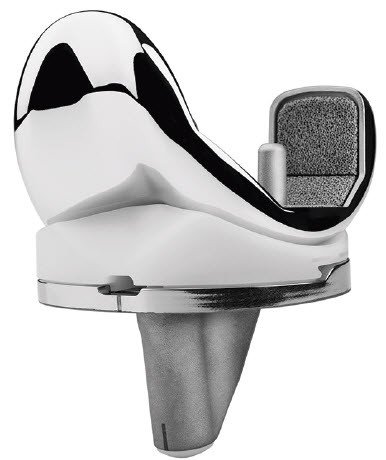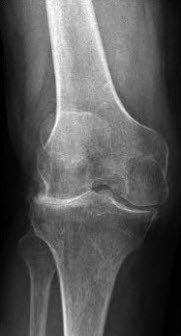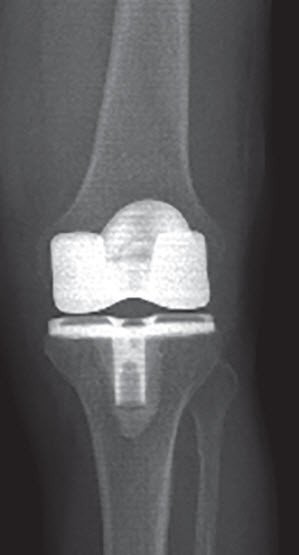Medical condition Knee prosthesis – the artificial knee joint
An artificial knee joint is used to replace the natural sliding and surface areas of the knee joint when these have become worn.
The components for replacing these surfaces, the femoral cap and the tibial plate, are made from highly polished metal (cobalt-chromium alloy). Between the metal surfaces there is a cartilage replacement made from polyethylene (a highly advanced plastic). Once the components of the artificial knee joint have been implanted in the body, they are held together in a stable position and guided during movement by the knee’s own ligaments, the joint capsule and the strength of the muscles.
Special bone cement is generally used to attach the metal surfaces to the bone. If the bone is of very high quality, a knee prosthesis can also be implanted without using cement. When attaching the metal to the bone without using cement, the back of the metal components is covered with a special surface which allows for the ingrowth of bone cells.
In Switzerland, around 16,000 artificial knee joints are implanted every year, about 850 year at Schulthess Klinik. Implanting a knee prosthesis is therefore a routine operation and is usually very successful.

Osteoarthritis of the knee
Osteoarthritis, a degenerative and mostly age-related wearing of the cartilage surfaces, causes inflammation and therefore pain in the knee. Gradually, the bone structure is damaged further and mobility is significantly restricted. Osteoarthritis cannot be healed and it usually progresses until the knee joint is completely destroyed. Wear of the knee joint is the most common reason for knee joint replacement.
Osteoarthritis can also develop as the result of inflammatory rheumatism or years after knee injuries or after meniscus surgery. The extent of the knee pain, limping and the associated disability are key factors in a patient’s decision to consult the doctor. This suffering, more so than age, is a critical consideration when deciding to implant an artificial knee joint. An important prerequisite is that all conservative and therapeutic (non-surgical) measures currently available have been exhausted or no longer have any effect.


Surgical treatment
Hospital admission is usually on the day of the operation. The operation can be carried out under general or local anaesthetic and usually takes around 75 minutes. The knee joint has to be opened up from the front through a skin incision of around 15 to 20 cm in length.
The worn surfaces of the joint are worked on according to a special cutting plan and prepared for the artificial surface replacement. The exact size and type of prosthesis are selected on the basis of the preoperative X-ray images and measurements taken during the operation.
Leg axis deviations caused by osteoarthritis, such as bow legs or knock knees, are also corrected during the operation. Blood loss during and, above all, after the operation is unavoidable. Although this is rarely so severe as to necessitate a blood transfusion, the need for a transfusion cannot be completely ruled out.
Metal allergies
In the case of known and severe nickel or metal allergies, the advisability of allergy testing for sensitivity to the metal used will be discussed. For metal allergies, there is the option of using an anti-allergenic knee prosthesis, although this is very rarely required.
Follow-up treatment and rehabilitation
In the period immediately following the operation, pain management and physiotherapy are prioritised. Successful pain management is very important to us. Pain therapy following the operation draws on a number of disciplines in collaboration with anaesthesiology specialists, physiotherapists, nurses and the attending doctor. At the end of the operation, a local anaesthetic is injected so that the pain after the joint “wakes up” is already lessened. Pain is controlled and managed directly after the operation with a strict programme of pain medication.
The patient is usually discharged from hospital four to six days after the operation. If the patient is at home alone after being discharged, or if they have to climb a lot of stairs, we recommend that they make use of our aftercare service or ask for help from family members. Inpatient rehabilitation is not usually necessary. Continuing physiotherapy on an outpatient basis should, however, not be neglected under any circumstances. Our case management team is happy to help with any enquires about an inpatient stay in a rehabilitation clinic or spa treatments following discharge from Schulthess Klinik. Clarifying the coverage of costs for rehabilitation of this kind in good time is strongly recommended.
Physiotherapy and movement
Thanks to pain management mobilisation by a physiotherapist is possible on the day of the operation itself. With active and passive physiotherapy, adhesion of the sliding surfaces in the knee joint with potential restriction of mobility is prevented. During their stay patients are personally daily by a physiotherapist.
We recommend that you use walking sticks for four to six weeks, but it is generally possible to bear weight on the affected knee up to the pain threshold. After being discharged from the hospital, physiotherapy usually takes place twice a week over a period of three to four months.
No dental work after a knee operation
Any foreseeable dental work should be carried out before a knee operation. Good and regular dental hygiene is important. Dental work should not be carried out in the first three months after the knee operation unless due to an infection. Before dental procedures, it is important to rinse the mouth with an antiseptic. Prophylaxis with antibiotics before going to the dentist is only considered in rare cases in immunosuppressed patients. (Recommendation in accordance with the review article of the expert group 'Infection' of Swiss Orthopaedics, Sendi et al, J. Bone Joint Infect 2016; 1: 42
Healing and chances of success
The statistics confirm that in over 90 per cent of cases, patients are very satisfied with their artificial knee joint and are able to live a normal, carefree life. Long-term results also show that a correctly implanted and well-healed artificial knee joint can continue to work without problems for more than 15 to 20 years. After this time, it’s mainly wear and tear that will lead to individual components or the entire artificial knee joint needing to be replaced.
It is also important that the range of motion can be regained. We aim for flexion of over 110 degrees, but flexion of between 110 and 130 degrees is achieved in most cases without any problems. However, it usually takes twelve to eighteen months after the operation before the final healing outcome is by and large achieved.
The skin at the front of the knee often stays numb for a long time because the skin nerves have to be cut through during the surgical procedure. In rare cases, this feeling of numbness can be permanent.
You can largely lead a normal life with an artificial knee joint. High-risk sports and contact sports such as football and activities involving excessive strain on the knee joint including jogging and stop and go sports such as tennis should be avoided, whereas low-impact sports like cycling, golf, hiking and skiing can be enjoyed in moderation with an artificial knee joint.
Complications and risks
The knee prosthesis operation is an elective procedure and not an emergency operation. Preparations can be made without any sense of urgency, meaning that potential risks or complications can be kept to a minimum.
Despite preventative measures, there are certain risks involved when having a knee prosthesis operation, as there are with any type of surgery. The possible risks of the operation include, among others, thrombosis, embolisms, infections, wound healing disorders, bruising and post-operative bleeding, damage to nerves, vessels or other anatomical structures, adhesions resulting in poor mobility and functioning of the knee joint as well as residual pain, to name but a few. These risks will be explained to you in detail in an informative discussion with your doctor. All of these risks occur in less than 1 per cent of cases and should not put you off a knee prosthesis operation.



